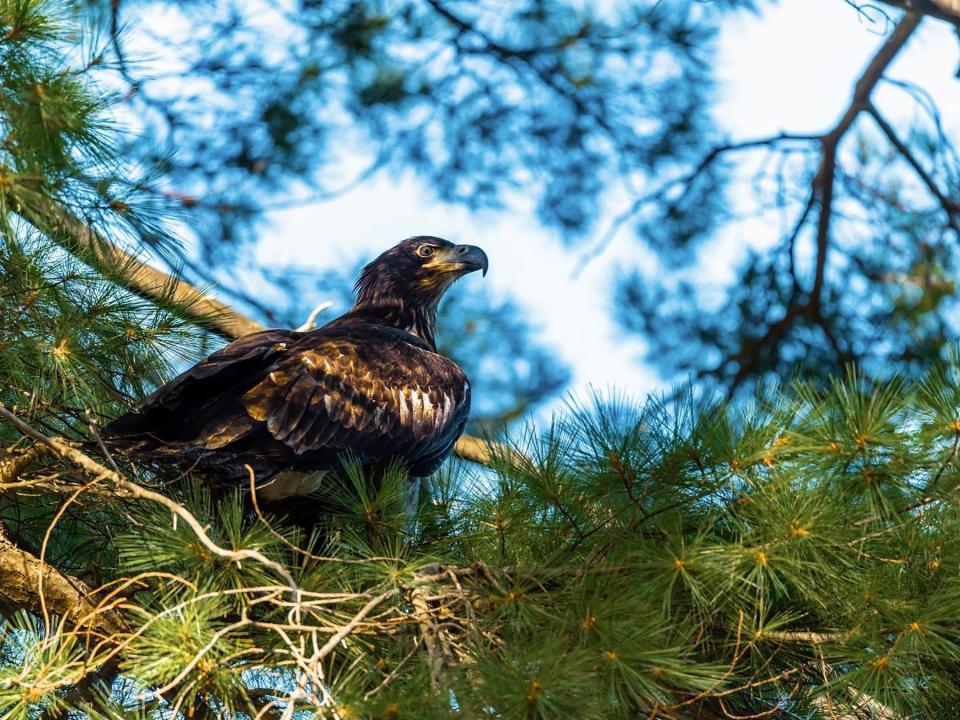Bald eagles have long been a presence in the nation’s imagery, but it wasn’t until recently that Rhode Islanders could see them in the sky.
“The bald eagle population [in Rhode Island] is growing rapidly, but you don’t have to go too far back in our history when the state was devoid of the species altogether,” said Dr. Charles Clarkson, director of avian research at the Audubon Society of Rhode Island.
Before the 1980s, the national bird was considered an “irregular visitor,” either passing through the state or using it as foraging habitat, rather than nesting, preferring to breed and raise their young in northern New England.
Now, following intensive conservation efforts in other parts of the region, bald eagle populations are shifting southwards, taking up permanent residence in areas where they have never been seen before. What changed?
Why bald eagle populations are growing in Rhode Island
“We kind of hit the sweet spot from the late ’80s to the early 2010s for a massive resurgence [of eagles] in New England,” said Clarkson.
Eagle nesting territories can cover over three miles, meaning that as the population started to recover in other states, there would be inevitably more birds than the habitat in those states could support. This would lead to what was essentially spillover as young birds began striking out on their own to find new territories outside the species’ traditional range.
Birding: Your guide to summer birding in Rhode Island: Where to go and what to see
Clarkson said the first state record of a nesting pair in Rhode Island was in 2003 at the Scituate Reservoir, but said the birds had likely been there for quite some time before being reported. Between 2015 and 2019, four other eagle nests were confirmed, and with more being reported annually since then, the Rhode Island population has grown to six or seven active nests.
Why were bald eagles not in Rhode Island before?

An ideal breeding habitat for bald eagles requires large, mature trees in heavily forested areas to support their fortress-like nests, along with an abundance of freshwater lakes, ponds and rivers for food, as fish is one of their preferred prey items. All of that was available in the north, such as Maine and New Hampshire, and breeding pairs had little reason to come south.
That being said, Rhode Island has always been useful foraging habitat for the eagles and other fish-eating raptors, flying south in the non-breeding season – winter – looking for open bodies of water to hunt when the water in their home territories froze up.
So while the Ocean State was a good place to raise an eagle family, it just wasn’t needed until recently.
“The habitats we have in southern New England are high quality enough to support eagles, but now the regional population is large enough that they are being used,” explained Clarkson.
The necessary mature, intact, contiguous forests are present in the western part of the state, with trees like Eastern White Pine that are capable of supporting a massive bald eagle nest, “but we don’t have a hyper-abundance of these forests.”
He expects the bald eagle population will continue to grow and likely will do so as long as it has the requisite resource to support it − that is to say, trees. “Trees are definitely a limiting resource,” said Clarkson, though he doesn’t see that upper limit being reached any time soon.
Where is the best place to see bald eagles in Rhode Island?
During the winter months, staying by any ice-free body of water is your bet, and areas along the southern coast such as Easton Pond are prime spots. With enough patience, there’s a high chance you’ll catch an eagle fishing for its dinner. (These are) an exceptional location to see an eagle,” said Clarkson. “They show up in relatively large numbers to forage.”
More: What killed Cranston bald eagle? Wildlife rehabilitator thinks rat poison is killing raptors
During breeding seasons, a walk in the woods is the way to go, as they will be tied to their nesting area, which can be anywhere from two to three miles across, meaning it’s more a matter of the right place at the right time.
This article originally appeared on Telegram & Gazette: Bald eagles didn’t nest in RI until recently. Here’s what changed
Signup bonus from




